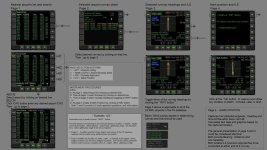Hi 10Gallon,
Slightly off-topic, but do you (or any other draken pilot, for that matter) know how to get any vertical speed indication in this aircraft?
I looked through the manual, but can't seem to find any mention, neither did I find any in the virtual cockpit itself.
Maybe its "hidden" in some of the other gauges, since I can't imagine that Sweden built an all-weather, IFR capable fighter/interceptor without
such a basic instrument.
While the manual advises to fly a 3 degree descent profile in a curved approach from downwind to final,
I'm not sure how this is going to be accomplished without a descent rate info.
Oliver
I created an instrument that does that .
1. It detects your Nearest airport or you can enter any airport worldwide into it .
2. It gives you Distance and Bearing and a Steering arrow to your selected airport , regardless of how far the airport is from your aircraft's current location , there are no distance limitations .
3. You then view all the Runways that are available at that airport and select the one that you wish to use .
4. You then select which end of your chosen runway you want to land on .
5. you are then presented with with all data relevant to your approach runway , this includes ;
* A full high precision ILS Deviation bars ( Glideslope and Lateral (LOC) bars ) .
* The ILS Deviation bars provide the usual guidance to the ILS aimpoint (touchdown point ) on the runway .
* The instrument automatically computes a " Synthetic ILS " aimpoint at 6% in from the end of your chosen runway length .
* The default Glideslope angle is the usual 3.00 degrees , but you can enter and use any angle that you desire .
* Regardless of your distance or height , the instrument gives you a readout of your current instantaneous ,
--- actual current Glideslope angle relative to the Touchdown spot on runway , and
--- current Height in feet above your runway .
--- current offset distance ( Circuit width ) from the Runway Heading axis .
...... so if you are flying the Downwind circuit leg ( ie; reciprocal of Runway Hdg ) , you observe the current actual Glideslope angle
readout , and either wait till it reads 3.00 degrees , or you climb or descend to get 3.00 degrees .
Once you get 3.00 degrees you turn to the runway and maintain the 3.00 degrees by adjusting your Pitch angle .
Your approach can be made using Readout data or the usual ILS deviation bars .
* ILS Deviation bar tolerances are the usual real life values .
--- Vertical = Glideslope = +/- 0.7 degrees relative to whatever glideslope angle you happen to chose to use.
--- Horizontal = equivalent to LOC = +/- 2.5 degrees relative to your Runway Hdg .
-- NOTE :- it is a " Synthetic ILS " therefore you do not have to set ILS frequencies to your radio.
* This Synthetic ILS provides full precision ILS approach guidance to every one of the 24,491 Airports that exist in the
Flight Simulator database , and for all runways at any airport , and at either end of any runway .
Special Note : as the Synthetic ILS utilises the " Runway Heading axis " , I included a " INTERCEPT " facility ,
you can enter a Distance in Nautical Miles ( eg; 7.1 nm ) , it then generates a location that Distance prior to the ILS aimpoint
on your Approach ( Runway Heading axis line ) , it then gives you the ( Direction , Bearing , Steering arrow ) to the Intercept position ,
it also gives you the Height above the runway to intercept the glideslope at that point .
The intercept feature informs you that you you need to descend from your cruise altitude down to that given height to accurately
capture the glideslope .
As you can see if you use this in conjunction with a Radio NAVAID ILS it will give guidance to ILS capture prior to engaging Approach Hold.
Cheers
Karol






 I did my military service in a Draken squadron, but the closest I got was to sit in the cockpit trying not to touch anything in the tiny little space.
I did my military service in a Draken squadron, but the closest I got was to sit in the cockpit trying not to touch anything in the tiny little space.



























